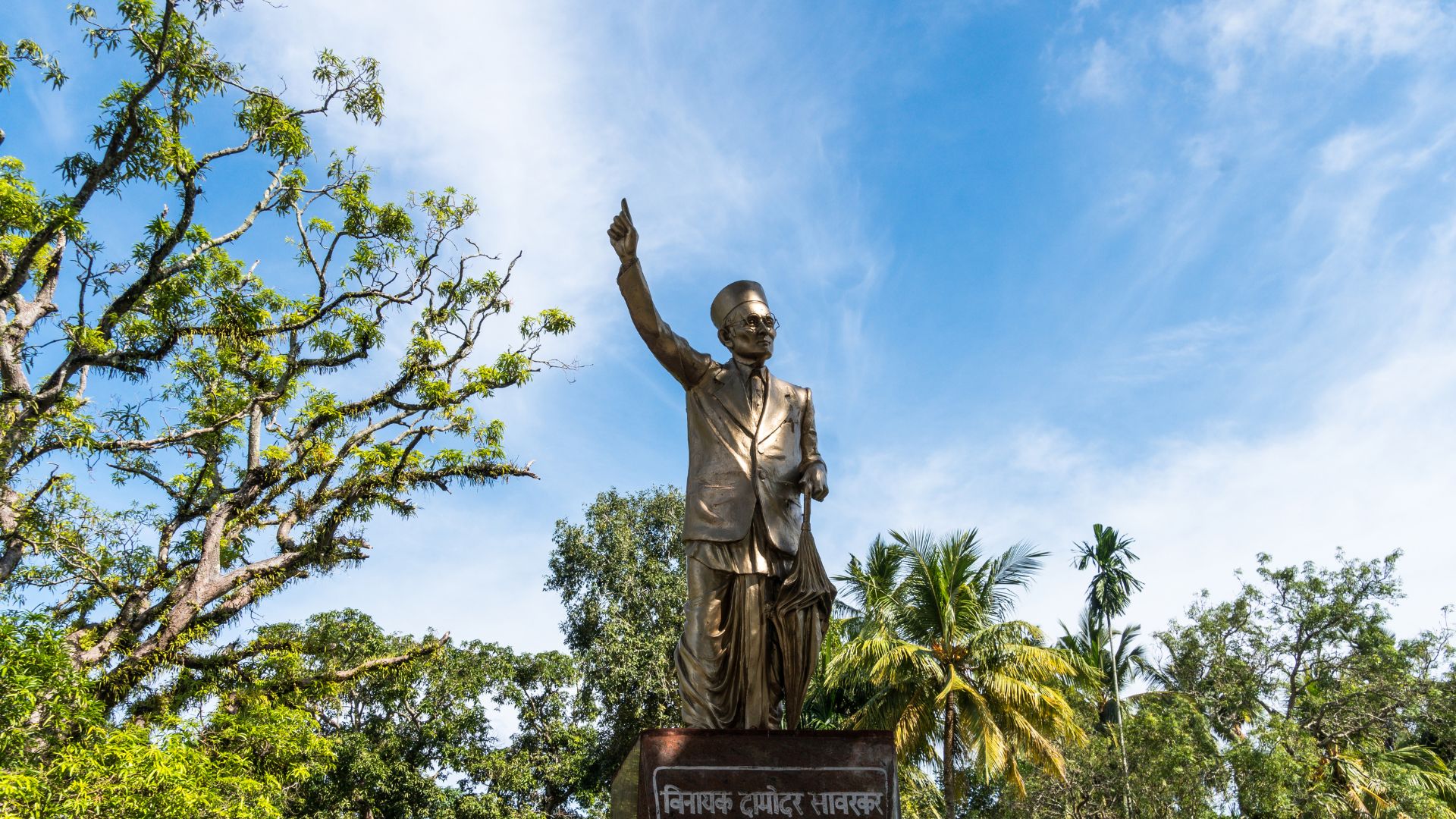For the final installment of our series, our focus shifts to key Hindutva ideas. The man who formulated Hindutva was Veer Savarkar. Savarkar was a leading figure of the Hindu Mahasabha and the Rashtriya Swayamsevak Sangh (RSS). He was an atheist but a pragmatic practitioner of Hindu philosophy. Out of the RSS, emerged the Bharatiya Janata Party (BJP). The ruling party still remains closely linked to the writings and thoughts of Savarkar.
In 1923, Savarkar published his canonical work, Essentials of Hindutva, in which he outlined the principles of Hindutva and his vision of a Hindu Rashtra (translated as Hindu Polity). He stressed social unity amongst the Hindu people and the unequivocal protection of Hindu people and Hindu culture.
(Click here to read Part 1 and Part 2 of this three-part series.)
A Hindu Rashtra would establish India as a Hindu, rather than a secular, state. Hinduism would be the state religion, though other religions would still practice freely. Importantly, For Savarkar, political power is defined as ‘the power of law with an organized military force,” and is critical for Hindus. Hindu Rashtra does not include a legal system derived from Hindu scriptures. In fact, the BJP wants a Uniform Civil Code (UCC) with a single personal law irrespective of religion.
M.S Golwalkar’s version of a Hindu Rashtra excludes Muslims and Christians from citizenship. Hence minorities fear that in a Hindu-majoritarian polity, they would be adversely impacted. They believe that minority groups will have their freedoms threatened, and constitutional rights stripped. Patriarchal notions of marriage as a social contract in which duties between men and women are clearly demarcated, may reemerge too. However, such moves will surely engender heavy opposition and are also unlikely to succeed.
The following article examines current issues and debates around Hindutva; challenges certain assumptions about the BJP and the RSS; and offers prescriptions moving forward.
Grassroots Movements, Democracy, and India
In December 2019, the BJP passed the Citizenship Amendment Act (CAA). The bill opened an expedited path for Indian citizenship for non-Muslim migrants who had arrived from Afghanistan, Bangladesh, and Pakistan before December 31st, 2014.
The BJP said that the bill will give sanctuary to religious minorities fleeing persecution. Non‐BJP states refused to support it. Critics argued that the bill will be used in tandem with the proposed National Register of Citizens (NRC) – an official census that would identify legal citizens of India and irregular immigrants- in order to further disenfranchise Muslims.
The register, they argued, would put millions of Muslims at risk of arbitrary detention and statelessness. The BJP later clarified that the CAA and the NRC are designed to control the influx of illegal migration of Bangladeshi Muslims, not to strip Indian Muslims of their citizenship. Every sovereign country has the right to regulate its borders. Further, given that millions of Pakistani and Bangladeshi Muslims voluntarily left the country in 1947, the BJP is fully justified to offer refuge only to persecuted non-Muslims.
In 2020, widespread protests erupted after the CAA was passed. Dalits and Muslims, and left-leaning Hindus demonstrated together in solidarity. The sheer size of the demonstrations is evidence of a formidable social and political alliance in the making. Dalits (untouchables) comprise around 25% of the Indian population across various religions. 75% of Muslims are Dalits. In response, the BJP convened a historic meeting with Pasmanda Muslims (i.e., Backward, Dalit, and tribal Muslims).
The farmer protests in North India, similarly, led the BJP to repeal the farm reforms just before the Punjab elections. The protests, which lasted for sixteen months were led by the Sikhs, who are less than 2% of the population.
The two demonstrations yielded attention and concessions from the ruling party. Legislative victories may be easy to acquire for the all-powerful BJP (the abrogation of Article 370/35(A) on Kashmir, for example), but the party did only win 37.36% of the votes cast in 2019 (INC only 19.5%). This was the highest-ever national vote share for the BJP. However, this also means that a good 62% did not vote for them. These numbers do not include alliances (NDA versus UPA). The numbers highlight the potential street power that could be unleashed by a contentious bill.
In September 2018, the RSS chief reiterated that Indian Muslims will not be excluded under a Hindu Rashtra, nor is there any proposal to change the constitution to do so. “Hindu Rashtra doesn’t mean there’s no place for Muslims. The day it becomes so, it won’t be Hindutva. Hindutva talks about one world family.” “The words secular and socialist were added later, but now they are there.”
In the midst of the ruling party’s efforts to calm tensions, the Varanasi-based Shankaracharya Parishad collected votes for a draft of their own Hindu Rashtra Constitution. Their constitution granted equal rights for people of other religions but not the right to vote. Varanasi is the proposed capital of the country. It is doubtful that it will succeed for the reasons given above.
Do What’s Possible Without Pain and Drama
There are immediate solutions to protect and spread Hindu culture and values. School textbooks should be revised to properly chronicle India’s cultural past, its Hindu kings and heroes, scientific discoveries, and the 1,200-year period under colonization.
Renaming roads and cities to remove colonial vestiges should be considered, although it is an expensive exercise. There are far more pressing priorities to manage such as smart fencing of India’s borders. Where essential, it is best to do this as one single project.
Hindu values of Dharma (leading a just and good life), Bhaichara/Bandhubhav (brotherhood/ fraternity), Samjhota (reconciliation), Namrata (kind/soft-hearted behavior), Karuna (compassion), Seva (service to society), Dana (charity), should be integrated into the school moral science course. It’s best to do this based on common values across religions and with proper referencing. Yoga should be encouraged for its physical aspects and global prominence.
The rights of women and the conventions of marriage must also adapt to a modern, digital age. Men and women have to jointly contribute financially to meet the high costs of living. Women can no longer be confined to the duties of the house. The RSS is aware that times have changed. In October 2022, Mohan Bhagwat, the head of the RSS, addressed the party’s view on gender equality. He spoke of the need to give women independence to work and equal rights in all spheres.
Akhand Bharat needs an Economic and Monetary Union
The appeal for a greater, unified India, an Akhand Bharat, has been a part of the country’s psyche ever since the end of Ashoka the Great and his colossal empire. It would include, in varying versions, Pakistan, Bangladesh, and portions of Afghanistan, Nepal, and Sri Lanka.
Akhand Bharat would reunify India with her neighbors but it would also heighten existing fears of Islamic radicalism and an Islamic State. Currently, the Muslim population in India is 14%; under Akhand Bharat, the number would rise to over 30%.
India’s military advantage compared to the rest of the subcontinent is substantial. But military conquest over an unstable nuclear state such as Pakistan is a highly risky proposition. Mutual destruction is a greater likelihood than a triumphant takeover. The RSS clarified that Akhand Bharat is a cultural construct, not a political program.
Akhand Bharat, like Hindu Rashtra, is a difficult ask for the immediate future. In the meantime, India should develop an economic and monetary union between the members of the South Asian Association for Regional Cooperation (SAARC). Relations between countries will be re-established, thus strengthening regional security and integration.
Regional security will be a bulwark against Islamist threats. Smaller countries will benefit from a larger, combined market as well as the stability of the rupee. Special travel cards for large businesses, investors, and families would help to integrate the region also.
What Drives the RSS? Integral Humanism or Brahminism?
The RSS has been accused of promoting Brahminism but this is a false accusation. In reality, the RSS are proponents of integral humanism, a philosophy and political program developed by Pandit Deendayal Upadhyaya. In 1965, it was adopted as the official doctrine of the Jan Sangh and later the BJP.
Upadhyaya acknowledged the merits of both Western capitalism and Marxist socialism but was critical of its excesses. Integral humanism sought a middle ground between both systems. For Upadhyaya, politics was a means to serve people. He advocated for an indigenous economic model that is inclusive and empowering to the masses.
According to Upadhyaya, humankind has four attributes: body, mind, intellect, and soul. In his view, capitalism, and socialism only considered the needs of the body and mind (i.e., based on the materialist objectives of desire (kama) and wealth (artha)). It ignores the intellect (towards dharma or moral duties) and the soul (towards moksha or total liberation or ‘salvation’).
As an example, a medical model of health focuses on biology, while an integrated approach looks at the body, mind, intellect, and soul. The practice of yoga is an example of this.
Integral humanism fosters wealth creation and redistribution, equal rights, equal opportunity, and social justice. Brahminism, on the other hand, has many traits that are antithetical to human equality. Many even view it as a racist philosophy.
Brahmins were largely responsible for keeping both Sanskrit and the Vedas away from common knowledge. According to Dr. Jacqueline Suthren Hirst, the Vedic hymns were not translated until the late 19th century as “Brahmin reciters were reluctant to break millennia of tradition that restricted the transmission to qualified Brahmins.” Adding to the complexity of caste equations, some have argued that the “Dalit-Bahujan religion and Brahminism are two distinct and mutually opposed religio-cultural formations, two completely different religions.
Brahminism is a religious and social system that is based on the Vedas and other priestly writings. They make up around 5% of the Hindu population. Many RSS chiefs were Brahmins and many have argued that the RSS promotes Brahmanism and vegetarianism in order to preserve the caste system. This is currently unlikely.
In October 2022, Bhagwat stated that concepts like varna and jaati, which forms the basis of the caste system, should be completely eradicated. Bhagwat, arguably, shares affinities with Sikhism, which has no caste system. Savarkar- to return to the beginning – also insisted that untouchability should be abolished in his 1931 essay, ‘Seven Shackles of the Hindu Society’. Prime Minister Narendra Modi, himself, was born into a lower class.
To completely erase the myth that the BJP promotes Brahminism, the ruling party should allow the entry and appointment of women and lower castes as priests to temples. Such was the case in Tamil Nadu in 2021, which the BJP welcomed. Furthermore, while abstaining from beef is stressed in contemporary Hinduism, the party should support one’s right to make their own food choices (other meats). Bhagwat talks of restrained non-vegetarianism, albeit it’s clear that the preference is for vegetarianism. However, this is unlikely to reflect in any policy shift.
But more broadly, we need to recognize the dignity of labor. Class prejudice in the United States is not as potent as it is in India. In the US, it is not unusual for people from different social and economic classes to mix and socialize. Hopefully, in due time, this will change in India. Bhagwat sees the lack of dignity for labor as the main reason behind unemployment.
The Hindi Debate
Currently both Hindi and English are the official languages of India. There is no national language, despite the fact that Hindi is spoken as either the first or second language by nearly 55% of the population. Hindi is the 3rd most spoken language in the world after English and Mandarin. In contrast, English is spoken by over 10% only; followed by Bengali (8%), Marathi (7%), and Tamil (6%).
Given its prevalence, it is a no-brainer that Hindi should be the national language. English was introduced only to raise Indian administrators (“Babus”) in order to serve their colonial masters. An alien language had now estranged Indians from their cultural roots and Vedic knowledge. Uniting the country under a vernacular language can help bridge the country’s many cultural and regional challenges.
Racism No Way describes language as being, “intrinsic to the expression of culture,” which serves, “an important social function and fosters feelings of group identity and solidarity.” “The suppression of the languages of minority groups,” it continues, “has been used as a deliberate policy in order to suppress those minority cultures.”
In 1835, Lord Thomas Babington Macaulay delivered his Minute on Education, a treatise that argued for the funding of English language education, as well as European learning, in India. The Minute became policy a month after its circulation. For Macaulay, the native culture, particularly Hindu, was an inferior one. Macaulay wanted to create “a class of persons, Indian in blood and color, but English in taste, in opinions, in morals and in intellect.”
Macaulay contributed to the demise of Sanskrit. Sanskrit was once the language of religion, philosophy, law, and science. Much of ancient Vedic knowledge was in Sanskrit. Eventually, texts were translated by Western scholars but they were marked by prejudices and ignorance. Today, most of India’s population cannot access these texts due to their limited, or complete lack, of understanding of Sanskrit. This makes it important to preserve mother languages like Sanskrit, and ancient sister languages like Tamil.
English should still remain an official language, given its universality and India’s growing international reputation. It is especially important for continuity in legal judgments, and scientific research/studies to keep India connected to the world. But the government should direct more provisions towards spreading Hindi, amongst its citizens as well as foreigners. In South India, however, this will be a particular challenge.
In August 2020, Tamil Nadu was the first state to reject the BJP’s three-language formula. Tamil Nadu had been following the two-language formula of English and Tamil. The state viewed the proposed policy as another attempt to impose Hindi, which they had kept at arm’s length. We should also consider the stress it places on young children to learn an additional language on top of English and their regional language.
The academic Hindi standard in Hindi speaking states is very high. This level of proficiency is not even in use on the streets of North India. To impose this standard unilaterally on non-Hindi states or to move college level scientific education to the Hindi medium would cause other issues. What we want is national integration and for Hindi to be used as a tool for this. A competency for everyday conversation (communicating with people at shops, restaurants, asking or giving directions, etc.) is sufficient.
In non-Hindi states, a basic Hindi language course should be required beginning at the 6th standard through the 10th standard. They need basic written and spoken skills. They will already know a smattering of Hindi thanks to Bollywood. There is no need to teach poetry and sophisticated literature in Hindi. After the 10th standard they should be freed up to focus on their 12th standard exams to apply to college.
This approach is far likelier to be accepted as a means for national integration rather than linguistic imposition. Therefore, it will likely gain support from states such as Tamil Nadu. It may still be resisted for political reasons, but it is far more likely to succeed.
The Modi government is rightfully proud of India’s glories, cultural achievements, and scientific contributions. India not only needs spiritual and cultural leadership but one that produces better economic outcomes for all. The BJP has proven itself already in issues as diverse as culture, infrastructure, technology, and national security. Arguably, they are the right party to lead India.
(Click here to read Part 1 and Part 2 of this three-part series.)
[Naveed Ahsan edited this article.]
The views expressed in this article are the author’s own and do not necessarily reflect Fair Observer’s editorial policy.
Support Fair Observer
We rely on your support for our independence, diversity and quality.
For more than 10 years, Fair Observer has been free, fair and independent. No billionaire owns us, no advertisers control us. We are a reader-supported nonprofit. Unlike many other publications, we keep our content free for readers regardless of where they live or whether they can afford to pay. We have no paywalls and no ads.
In the post-truth era of fake news, echo chambers and filter bubbles, we publish a plurality of perspectives from around the world. Anyone can publish with us, but everyone goes through a rigorous editorial process. So, you get fact-checked, well-reasoned content instead of noise.
We publish 2,500+ voices from 90+ countries. We also conduct education and training programs
on subjects ranging from digital media and journalism to writing and critical thinking. This
doesn’t come cheap. Servers, editors, trainers and web developers cost
money.
Please consider supporting us on a regular basis as a recurring donor or a
sustaining member.
Will you support FO’s journalism?
We rely on your support for our independence, diversity and quality.







Comment